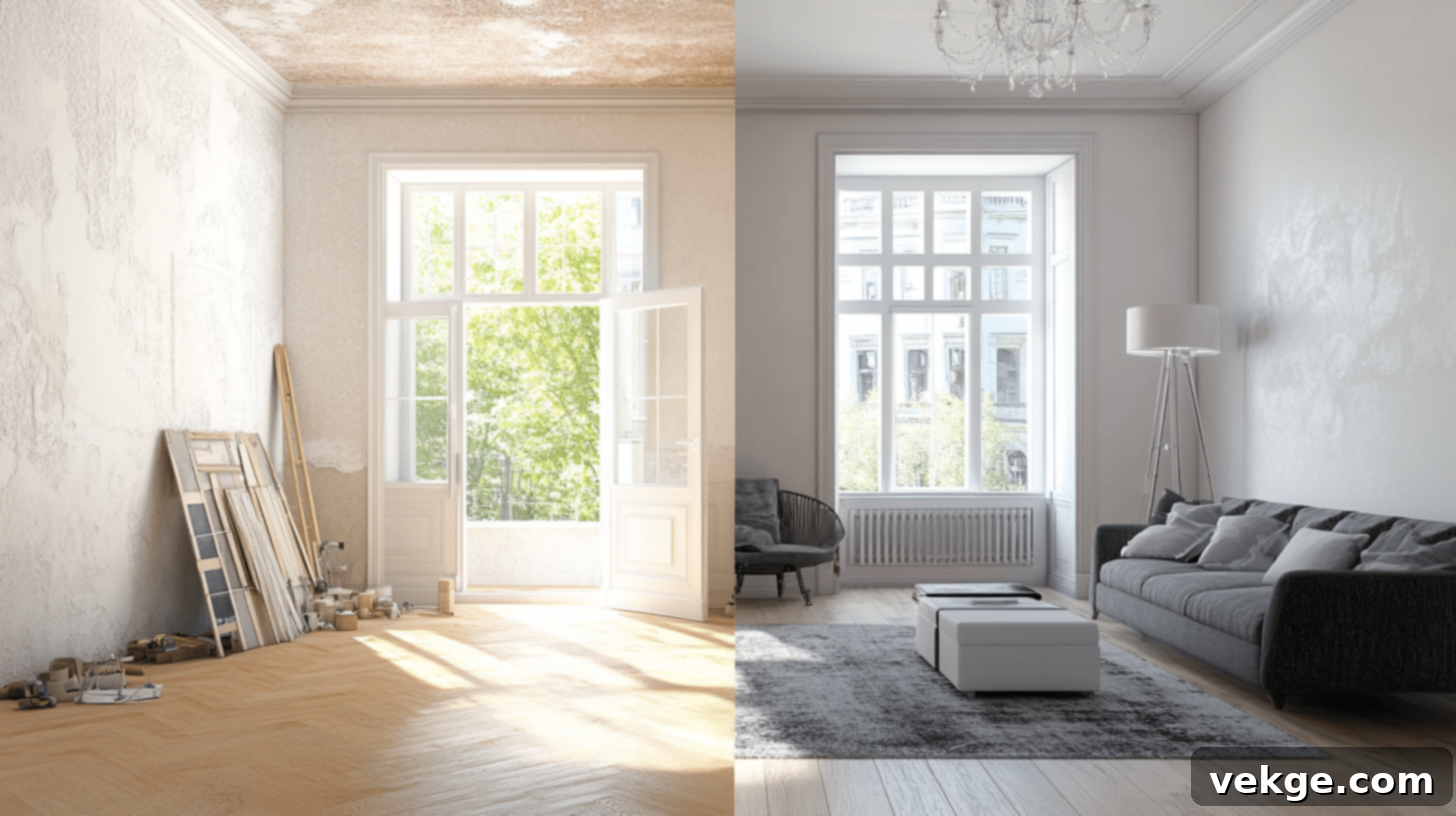Efficient Whole House Remodeling: Your Complete Guide to Planning, Costs, and Success
Embarking on a whole house remodeling project is an exciting journey that can transform an outdated or uninspired space into the home of your dreams. It’s more than just an update; it’s an opportunity to redefine your living environment, enhance functionality, and significantly boost your property’s value. While the idea of a complete home makeover sparks enthusiasm, it’s also a substantial undertaking involving considerable investment, time, and intricate planning. Many homeowners, initially eager, often encounter stress and unexpected hurdles when the project lacks a well-defined strategy.
The key to a successful whole house renovation lies in meticulous preparation. Establishing a realistic budget, setting a clear timeline, and assembling the right team of professionals are pivotal steps that will make all the difference. This comprehensive guide is designed to walk you through every critical stage of the process – from initial planning and accurate budgeting to selecting reputable contractors and adding those crucial final touches. With strategic foresight and diligent execution, your complete home transformation can be a remarkably smooth and rewarding experience, leading you to a home that perfectly reflects your lifestyle and aspirations.
Understanding the Costs of Whole House Remodeling
The prospect of remodeling your entire home is undoubtedly thrilling, but it’s essential to approach it with a clear understanding of the financial implications. Whole house remodeling costs can escalate rapidly if not managed proactively. Let’s delve into the various factors that influence your overall budget, enabling you to plan more effectively, minimize financial surprises, and make informed decisions.
Cost Breakdown by Room
The total cost of your home renovation will largely depend on which rooms you tackle and the extent of the changes. Here’s a general estimate for common areas:
- Bathroom Remodel: Typically ranges from $6,000 to $30,000. Costs vary significantly based on fixture quality (basic vs. luxury), tile choices, and whether you’re moving plumbing lines. A master bathroom often falls on the higher end due to its size and amenities.
- Kitchen Renovation: Expect to spend anywhere from $12,000 to $45,000 or more. This wide range accounts for cabinet styles (stock vs. custom), appliance upgrades, countertop materials (laminate vs. granite/quartz), and potential layout changes that involve plumbing or electrical work. Kitchens are often the most expensive room to remodel due to the sheer number of components.
- Living Room Update: Generally costs between $5,000 to $15,000. These projects usually involve cosmetic updates like new flooring, painting, lighting, and built-ins. Structural changes, such as opening up walls, will significantly increase this figure.
- Bedroom Makeover: Averages from $1,000 to $8,000. Most bedroom remodels focus on paint, flooring, closet organization, and lighting. More extensive changes like adding an ensuite bathroom or expanding the room will push costs higher.
- Home Office Transformation: Typically starts at $5,000 and can go much higher. This often includes custom cabinetry, enhanced lighting, soundproofing, and dedicated electrical outlets for technology.
Factors That Influence the Total Cost of Your Home Renovation
Beyond individual room costs, several overarching factors play a crucial role in determining the final price tag for your whole house remodel:
- Home Size and Scope of Work: Naturally, a larger home requires more materials and labor hours. A complete gut renovation will always be more expensive than superficial updates, involving tearing down walls, relocating utilities, and major structural modifications.
- Location, Location, Location: Labor costs, material prices, and permit fees vary significantly by geographic region. Urban areas or regions with a high cost of living generally have higher remodeling expenses.
- Layout Modifications: Changing the footprint or internal layout of your home by moving walls, rerouting plumbing, or altering electrical systems is far more complex and costly than simply updating finishes. Structural engineers and architects may be required.
- System Upgrades: Don’t overlook the “unseen” costs. Updating outdated electrical wiring, plumbing systems, and HVAC (heating, ventilation, and air conditioning) units can be a significant expense but are often essential for safety, efficiency, and modern living standards. These are critical components of a comprehensive house renovation project.
- Material Choices and Finishes: Your selection of materials impacts the budget dramatically. From basic, cost-effective options to high-end, luxury finishes, the choices for flooring, countertops, cabinetry, and fixtures will heavily influence the total cost.
- Unexpected Issues and Contingency: Older homes, in particular, often hide surprises behind walls and under floors – asbestos, lead paint, mold, water damage, or outdated wiring. Always allocate a contingency fund (10-20% of the total budget) to cover these unforeseen expenses.
- Professional Fees: Beyond contractor labor, factor in costs for architects, interior designers, structural engineers, and any necessary permits and inspection fees.
Planning Your Whole House Remodel

Successfully navigating a large-scale home renovation project hinges on meticulous planning. Before any hammers swing or contractors are hired, it’s crucial to invest time in defining your needs, articulating your desires, and establishing clear financial boundaries. This foundational planning phase sets the stage for a smooth and rewarding transformation.
Setting a Realistic Budget for Your Remodel
Financial clarity is paramount for any remodeling budget. Begin by honestly assessing how much you can comfortably afford to spend. This might involve tapping into personal savings, securing a home equity line of credit (HELOC), a cash-out refinance, or exploring specialized renovation loans. Be transparent with yourself about your financial limits.
A common pitfall is underestimating expenses. To mitigate this, always allocate a contingency fund, ideally 15-20% of your total estimated budget. This extra cash serves as a vital buffer for unexpected issues, material price fluctuations, or last-minute design changes. Detailed tracking of all expenditures as the project progresses will help you stay on budget and prevent costly overruns.
Defining Design Goals and Vision
Before you start browsing Pinterest boards, take a moment to reflect on the core reasons behind your complete home makeover. Is your family expanding, requiring more functional space? Do you need to improve the flow between living areas? What aspects of your current home frustrate you, and what elements do you absolutely adore? Create a comprehensive list differentiating “must-have” features from “nice-to-have” desires. This clarity will guide your design decisions and help professionals understand your priorities.
Consider your lifestyle, future needs, and personal aesthetic. Your remodeled home should be a reflection of you and your family, not merely a replication of current trends. Working with an architect or interior designer can be invaluable in translating your vision into practical, beautiful, and functional designs.
Securing Permits and Addressing Legal Considerations
While obtaining permits might seem like a bureaucratic hassle, it’s a non-negotiable step that ensures your home renovation is safe, compliant with local building codes, and legal. Most significant structural changes, electrical work, plumbing modifications, and additions require official approval from your local municipality.
The types of permits needed will vary based on the scope of your project. Failing to secure the necessary permits can lead to fines, stop-work orders, difficulty selling your home in the future, and even safety hazards. Reputable and experienced contractors often manage the entire permit acquisition process on your behalf, navigating local regulations and submitting required documentation, thereby saving you considerable time and potential headaches.
Step-by-Step Process of Whole House Remodeling
A whole house remodel is a complex symphony of tasks, each building upon the last. Understanding this sequence is crucial for managing expectations and ensuring a smooth progression. Here’s a detailed look at the typical steps involved in a comprehensive home transformation:
Step 1: Planning and Design

This initial phase is where your vision truly begins to take shape. You’ll work closely with architects, designers, and your general contractor to finalize blueprints, select materials, finishes, and color palettes that align with your budget and aesthetic goals. This is also the time to secure all necessary permits and establish a detailed project schedule. Thorough planning here prevents costly changes down the line.
Step 2: Demolition and Preparation
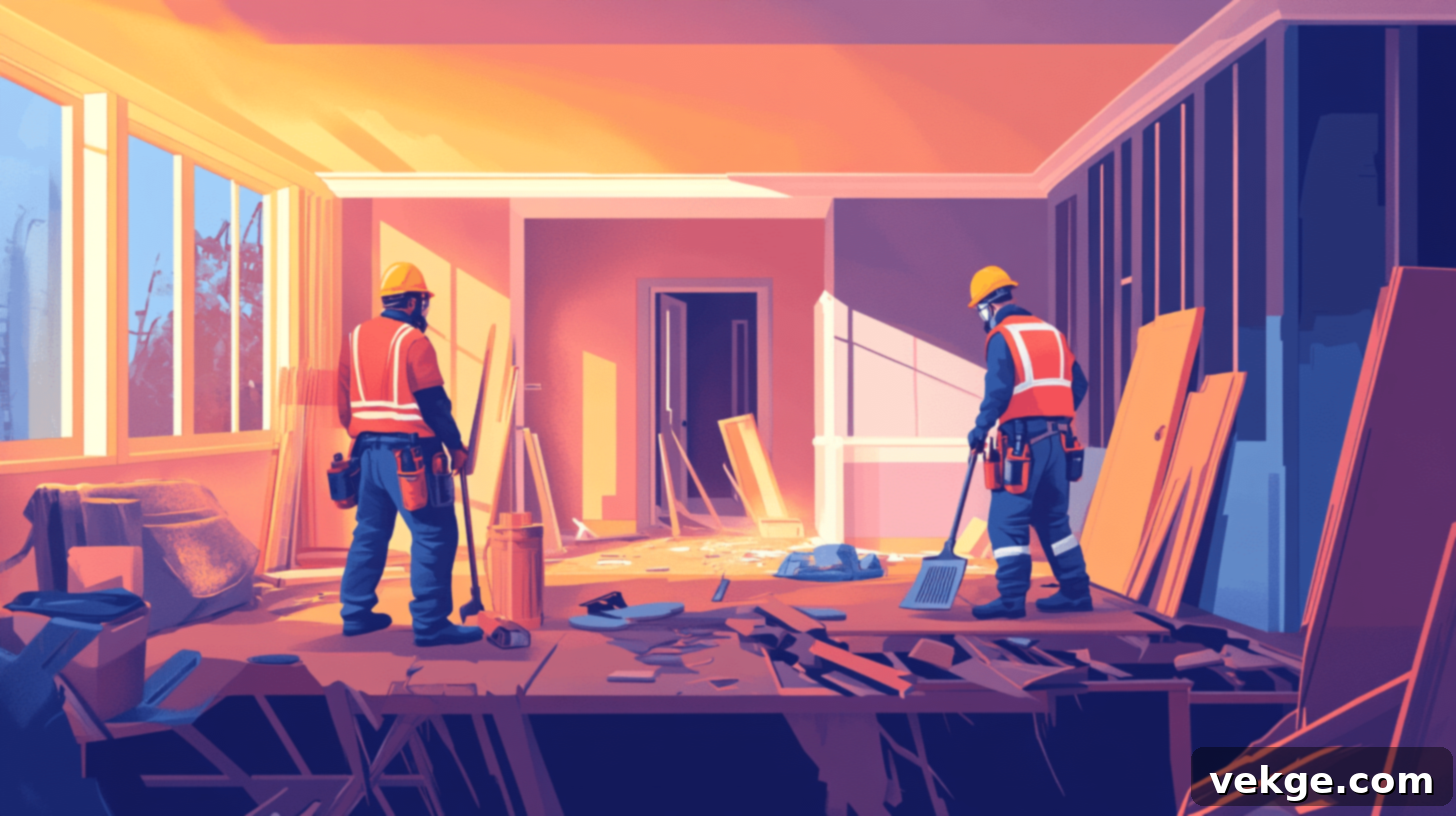
Out with the old, in with the new! This messy but exhilarating stage involves carefully removing existing structures, fixtures, and finishes that are no longer part of your vision. It’s crucial to identify and safely handle any hazardous materials like asbestos or lead paint during this phase. Proper waste disposal and site preparation are also key to ensuring a clean and safe working environment for subsequent steps.
Step 3: Structural Work (Framing and Rebuilding)
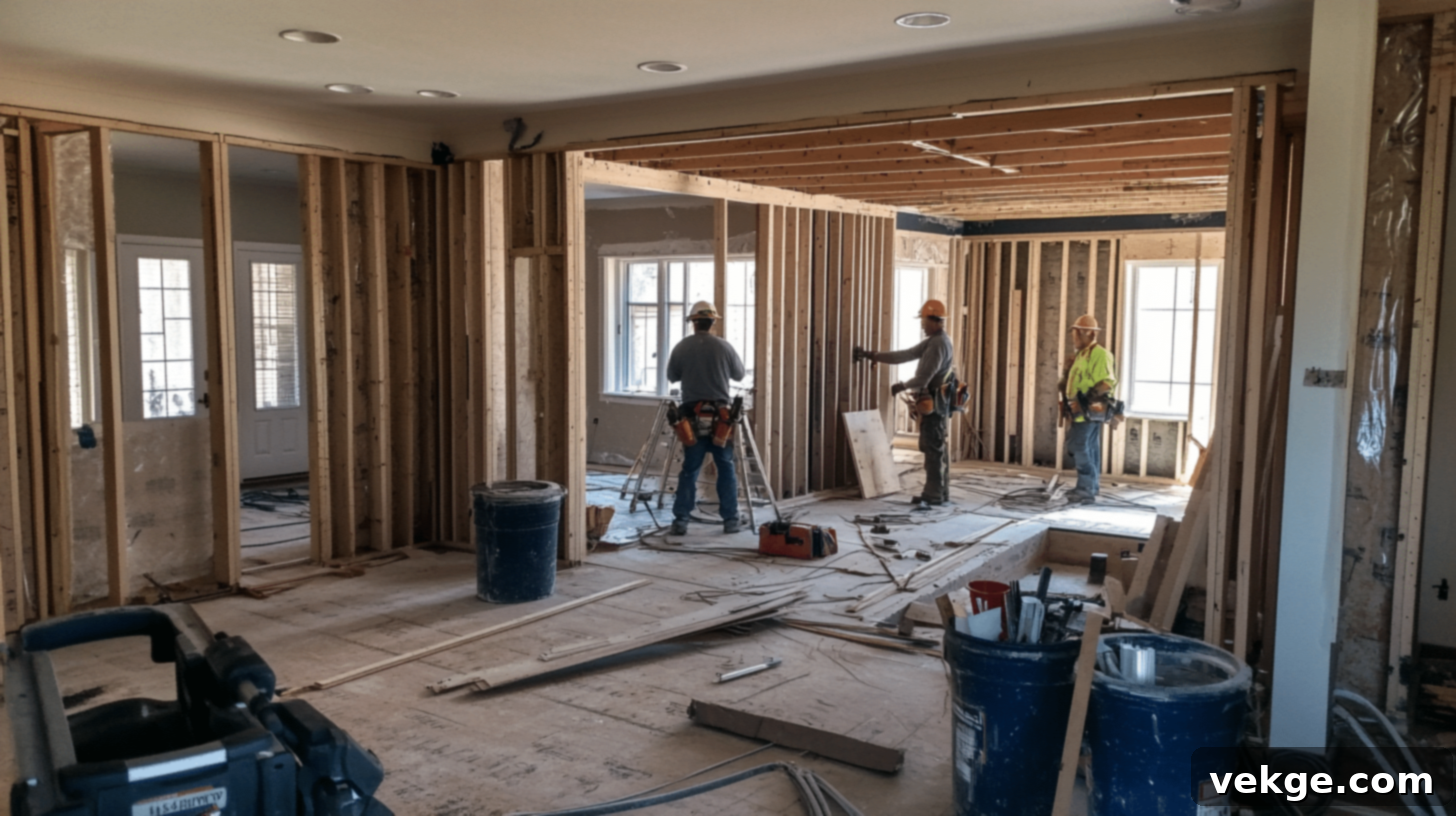
With demolition complete, your home’s new framework begins to emerge. This involves erecting new walls, altering existing ones, creating new openings for doors and windows, and ensuring the structural integrity of your home. This step is critical for defining the layout and flow of your redesigned spaces, effectively creating the ‘bones’ of your renovated home.
Step 4: Mechanical and Systems Updates (Rough-Ins)

This stage focuses on the vital, yet often hidden, infrastructure of your home. New electrical wiring, plumbing pipes, and HVAC ductwork are installed within the walls, floors, and ceilings. These ‘rough-ins’ must be meticulously planned and executed to meet modern safety codes and ensure optimal efficiency for years to come. Inspections by local authorities typically occur after this phase to approve the work before it’s covered up.
Step 5: Wall and Surface Finishes (Insulation, Drywall, Painting Prep)
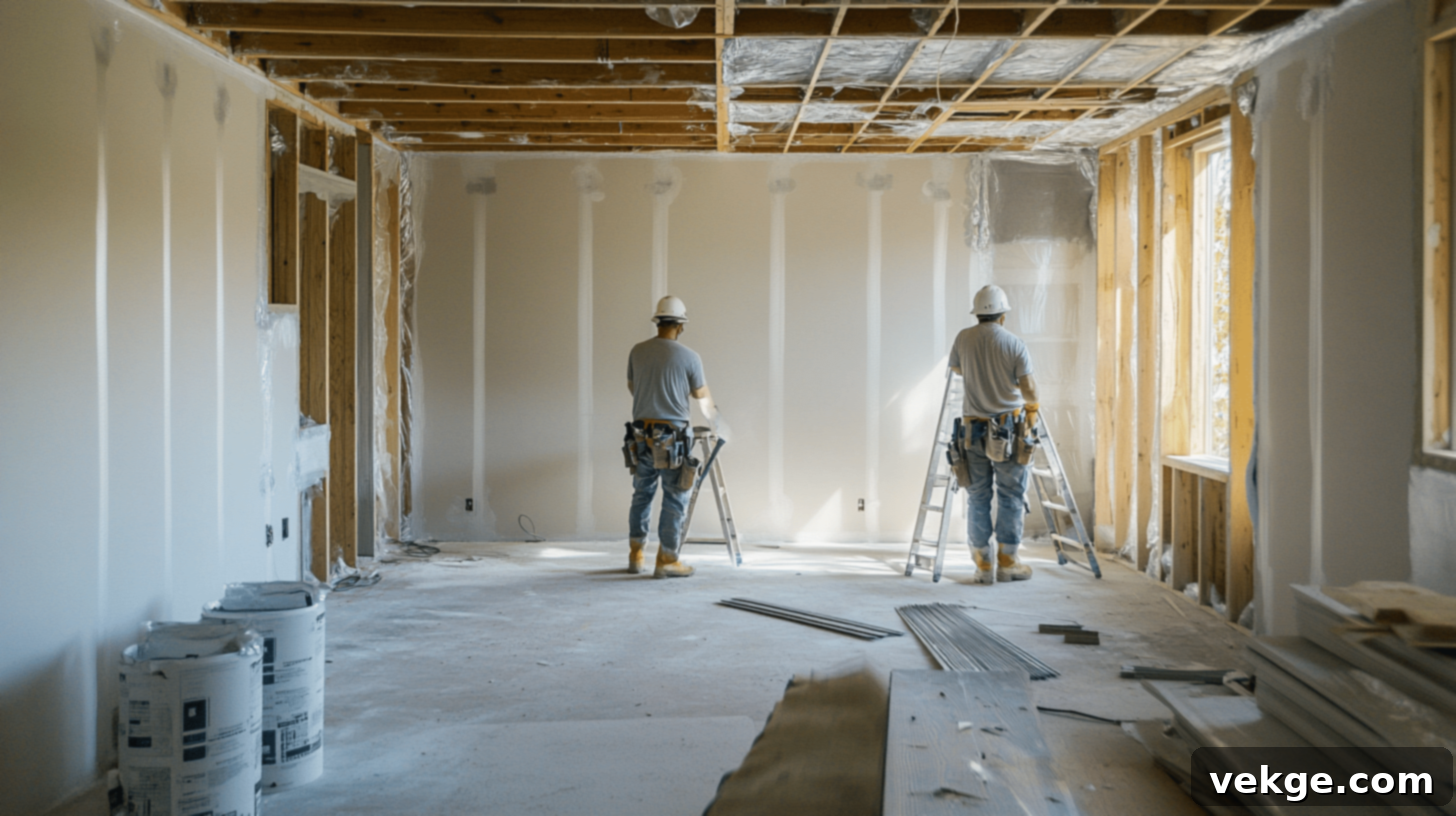
Once the mechanical systems are in place and inspected, insulation is added for energy efficiency and soundproofing. Then, drywall is installed, taped, and mudded, transforming bare frames into defined rooms. This prepares the surfaces for the primer and first coats of paint, bringing a sense of completion to the spatial definition of your new rooms.
Step 6: Flooring Installation
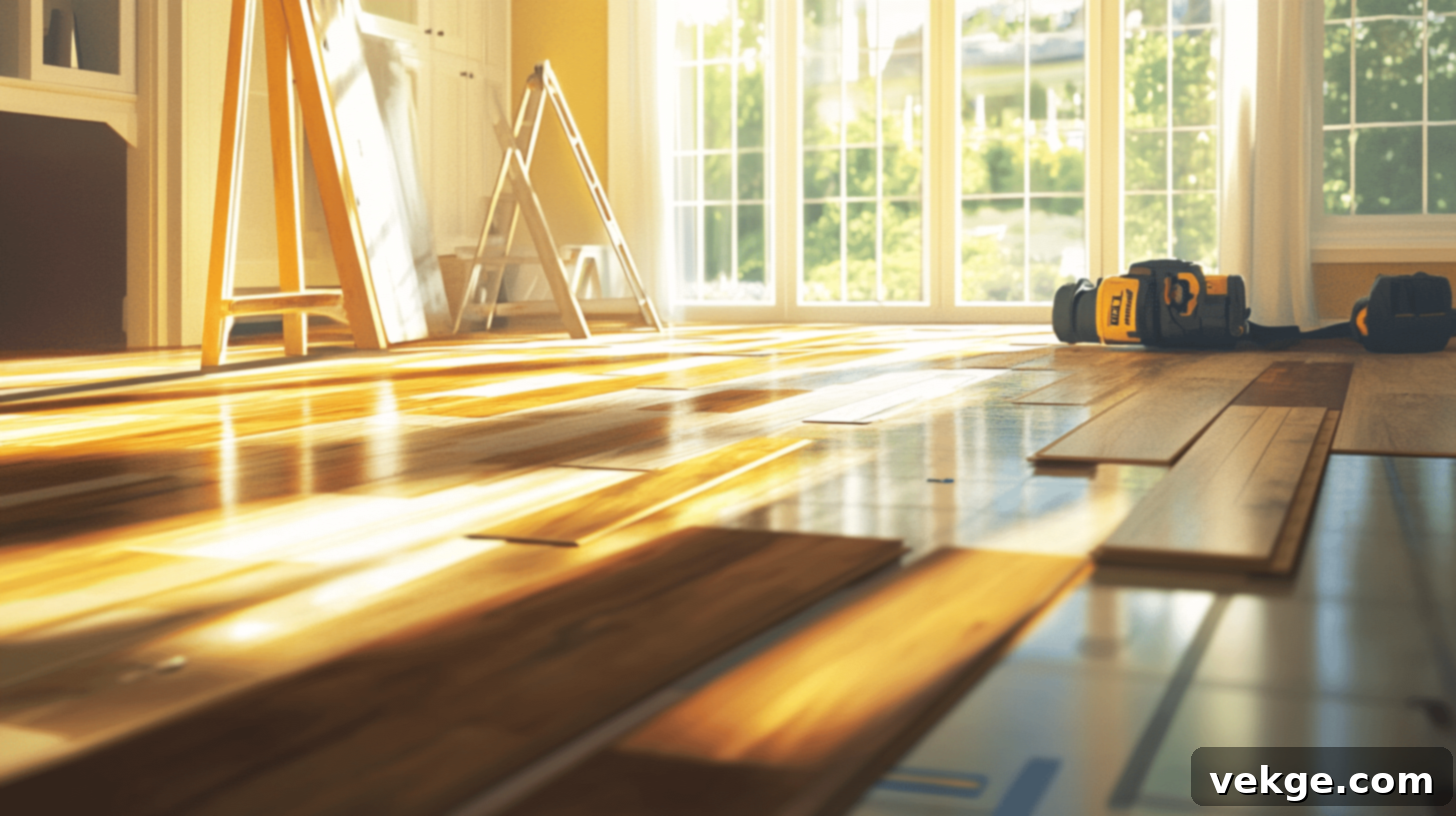
Choosing the right flooring for each room is crucial for both aesthetics and functionality. Hardwood, tile, carpet, or luxury vinyl plank each have specific installation requirements and timelines. Depending on the material, some flooring might be installed before cabinetry (e.g., hardwood throughout), while others, like tile, may be laid after the first coat of paint. Careful coordination is essential.
Step 7: Cabinet and Built-in Installations
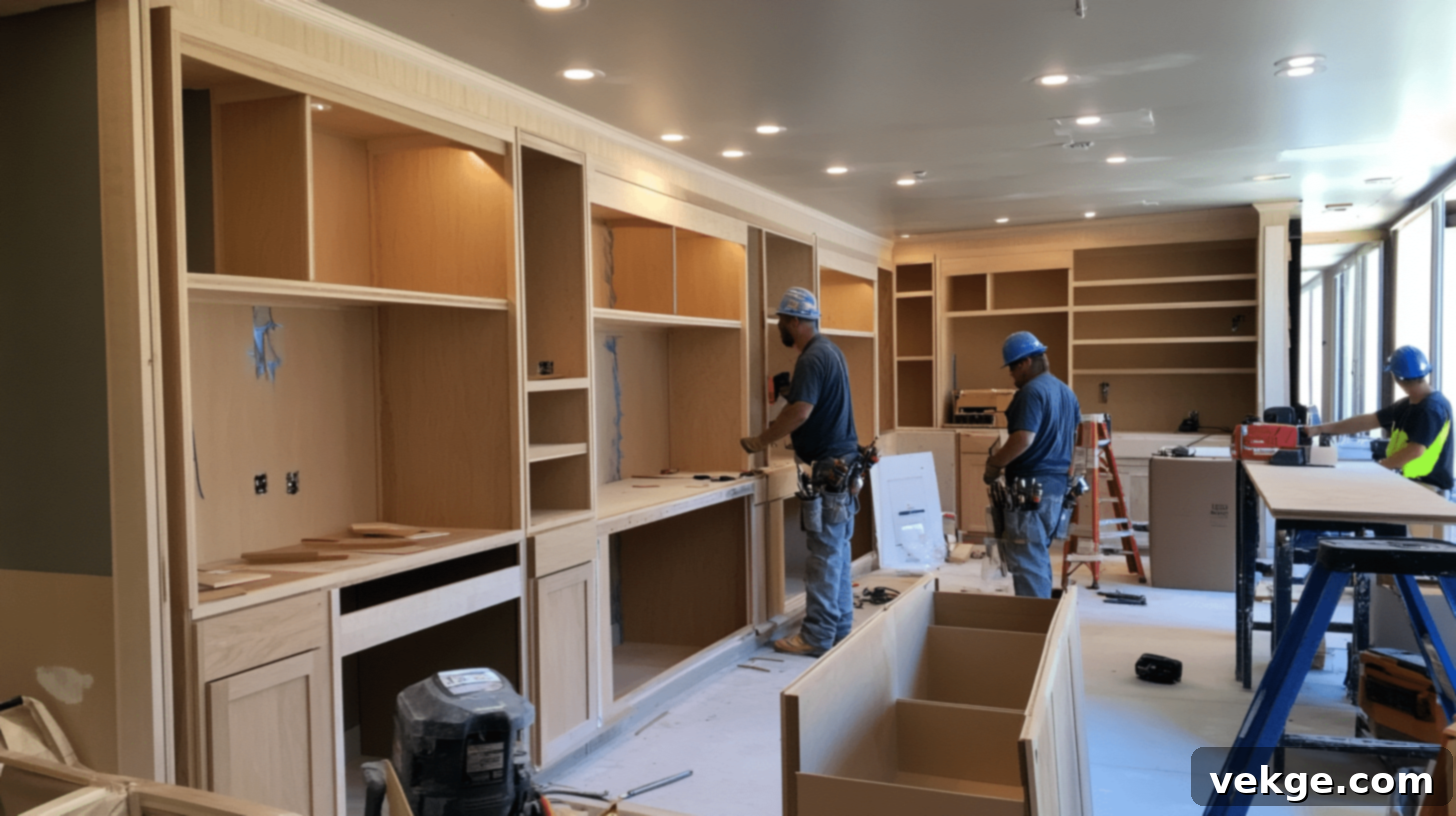
The installation of kitchen and bathroom cabinets, along with any custom built-ins like shelving units or window seats, happens next. This step brings significant functionality and style to these key areas. Precise measurements and skilled installation are vital to ensure proper fit and a polished finish.
Step 8: Appliances, Countertops, and Fixtures

With cabinets in place, countertops are templated and installed, followed by major appliances (refrigerator, stove, dishwasher, washer/dryer) and their final connections. Plumbing fixtures (sinks, faucets, toilets, showers) and light fixtures are also installed and tested during this phase, ensuring everything is fully functional and ready for use.
Step 9: Final Touches and Decoration

This is where your vision truly comes to life. The final coats of paint are applied, hardware (door handles, cabinet pulls) is installed, backsplashes are tiled, and final cleaning takes place. Once the construction dust settles, the most enjoyable part begins: adding your furniture, artwork, and personal decorative elements that transform the house into a warm, inviting home.
DIY vs. Hiring Professionals for Your Home Renovation
One of the most significant decisions you’ll face during your whole house remodel is determining how much of the work you’ll tackle yourself versus entrusting to professionals. While a DIY approach can seem like a cost-saving measure on paper, it’s crucial to weigh the time commitment, skill requirements, and potential risks against the benefits of professional expertise.
Tackling minor updates such as painting, installing new light fixtures, or basic landscaping can be incredibly satisfying and certainly help reduce labor costs. These projects generally don’t require specialized licenses or pose significant safety risks if done correctly. They allow you to infuse your personal touch and connect more deeply with your home’s transformation.
However, for a complete home makeover, especially one involving structural changes, electrical work, plumbing, or intricate carpentry, hiring licensed and insured professionals is almost always the wisest choice. Experts bring invaluable skills, experience, and efficiency to the table. They possess a deep understanding of building codes, the right tools for the job, and a network of trusted subcontractors. This can actually save you money in the long run by preventing costly mistakes, ensuring adherence to safety standards, and avoiding delays caused by inexperience.
Benefits of Hiring a Professional Contractor:
- Expertise and Quality: Professionals deliver high-quality workmanship that meets industry standards and local codes.
- Time and Efficiency: They manage the project schedule, coordinate tradespeople, and ensure timely completion.
- Permit Navigation: Experienced contractors handle permit applications and inspections, saving you bureaucratic headaches.
- Problem Solving: They anticipate potential issues and have the knowledge to resolve unforeseen challenges quickly and effectively.
- Insurance and Warranty: Reputable contractors carry liability insurance, protecting you from accidents or damages, and often offer warranties on their work.
- Access to Resources: They have established relationships with suppliers, often securing better prices for materials.
When DIY is Feasible:
- Cosmetic Updates: Painting, wallpapering, changing hardware.
- Simple Installations: Assembling flat-pack furniture, installing shelving.
- Demolition (Partial): Non-load-bearing walls, old cabinets (with extreme caution and proper safety gear).
- Landscaping: Garden design, planting.
The optimal approach for a whole house remodel often involves a strategic blend of professional assistance for the complex, critical elements and your own sweat equity for simpler, more cosmetic tasks. This hybrid method allows you to control costs where appropriate while ensuring the integrity and quality of your major investment.
Resale Value and Return on Investment (ROI) in Remodeling
Investing in home renovation isn’t just about immediate enjoyment; it’s also a strategic financial decision that can significantly impact your property’s future resale value. Smart remodeling choices today can translate into greater equity and potential profits when it’s time to sell.
Remodeling to Sell vs. Remodeling for Long-Term Living
Your motivation for remodeling should influence your project choices:
- Remodeling to Sell (Flipping): If your primary goal is to increase your home’s market appeal and maximize profit, focus on broad buyer appeal. Choose neutral palettes, popular finishes, and high-ROI projects that are widely desired. Avoid highly personalized or niche design elements that might deter potential buyers.
- Remodeling for Long-Term Living: If you plan to stay in your home for many years, your comfort, personal preferences, and lifestyle should take precedence. While considering future value is still wise, you have more freedom to incorporate unique designs and features that cater specifically to your family’s needs and tastes. Just remember that very personal choices might need to be toned down or updated before eventually selling.
Projects That Add the Most Value to the Home
Not all renovation projects yield the same return on investment (ROI). Some projects consistently deliver stronger returns by appealing to a wide range of buyers and enhancing key areas of the home:
- Kitchen Remodels: Both minor and major kitchen renovations consistently rank high in terms of ROI. Buyers often prioritize an updated, functional kitchen. Focus on modernizing appliances, refreshing cabinetry (or replacing), and updating countertops and backsplashes.
- Bathroom Upgrades: Similar to kitchens, updated bathrooms are a major selling point. Consider modern fixtures, new tiling, and improved storage. Adding an extra bathroom or expanding an existing one can also significantly boost value.
- Energy-Efficient Improvements: Investments in energy-saving features attract environmentally conscious buyers and those looking to save on utility bills. This includes upgrading to energy-efficient windows, installing new insulation, updating HVAC systems, and sealing air leaks.
- Adding Usable Square Footage: Finishing a basement or attic, or adding a sunroom, can substantially increase your home’s living space and perceived value, provided the quality of work is high.
- Curb Appeal Enhancements: First impressions matter! Exterior improvements like a new garage door, updated front door, fresh exterior paint, well-maintained landscaping, and a welcoming porch can significantly boost your home’s appeal and ROI.
Understanding Potential ROI in Different Remodeling Projects
The actual ROI for any given project can vary based on your local real estate market, the quality of materials, and the craftsmanship. Generally, mid-range remodels often yield a higher percentage return than luxury upgrades, as their cost-to-value ratio is more favorable. For instance, a minor kitchen remodel might recoup 70-80% of its cost, while a major, high-end kitchen remodel might only recoup 50-60%.
In a hot real estate market, almost any well-executed update can contribute positively to your home’s value. However, in slower markets, it becomes even more critical to be strategic with your spending, focusing on projects with proven high returns and broad buyer appeal to ensure your house renovation project pays off.
Common Remodeling Mistakes to Avoid
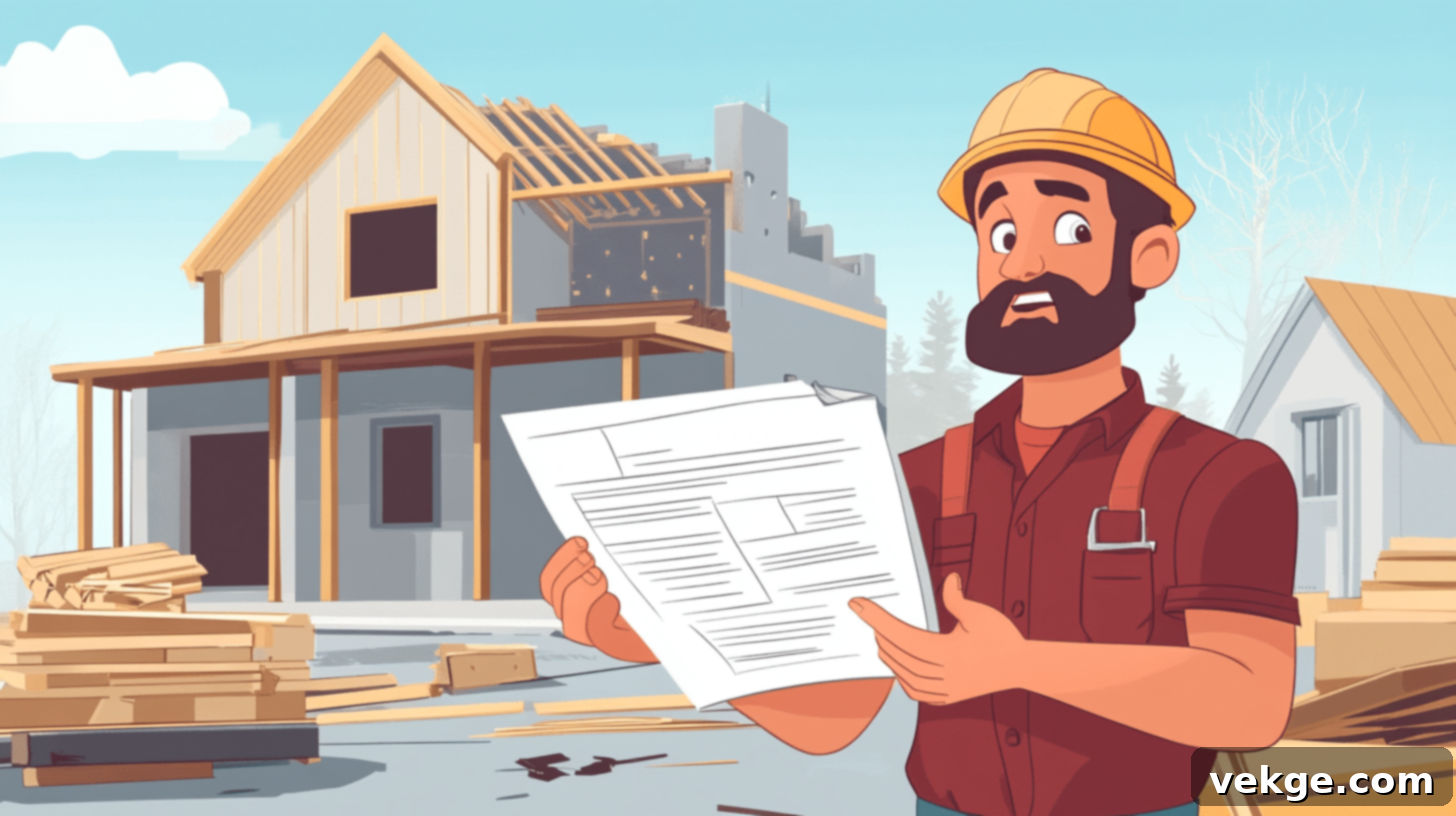
Even with the best intentions, home renovation projects can encounter roadblocks. Being aware of common remodeling mistakes can help you sidestep them, keeping your project on track, within budget, and as stress-free as possible. Learning from others’ missteps is a valuable strategy for your own complete home makeover.
Budgeting Errors
One of the most frequent and disheartening issues homeowners face is running out of money before the project is complete. This can lead to stalled projects, compromises on quality, or taking on more debt than planned. The excitement of design often overshadows the grim reality of finances.
- Insufficient Contingency Fund: As mentioned earlier, failing to set aside 15-20% extra for unexpected costs is a critical error. Older homes, in particular, often reveal hidden issues like outdated wiring, plumbing leaks, or structural damage once walls are opened up. This buffer saves immense stress.
- Not Tracking Expenses: Many homeowners create a budget but then fail to meticulously track every penny spent. Without this ongoing monitoring, it’s easy to drift off course. Use spreadsheets or dedicated budgeting apps to stay informed about where your money is going in real-time.
- Ignoring Small Costs: It’s easy to overlook smaller items like permit fees, rubbish removal, temporary living expenses, or even the cost of eating out more during kitchen renovations. These “little” costs add up quickly.
Hiring the Wrong Contractor
Your contractor is the backbone of your remodeling project. A poor choice can turn your dream renovation into a costly nightmare of delays, shoddy workmanship, and disputes. Trusting your gut is a start, but solid due diligence is essential.
- Skipping Reference Checks: Always check references from previous clients. Ask about communication, adherence to budget and schedule, and how the contractor handled problems.
- Not Verifying Credentials: Ensure the contractor is licensed, bonded, and insured. Ask for proof of insurance to protect yourself from liability in case of accidents on your property.
- Lack of a Detailed Contract: Never start work without a comprehensive, written contract. It should include a detailed scope of work, payment schedule, timeline, specific materials to be used, change order procedures, and warranty information.
- Going for the Lowest Bid Exclusively: While price is important, the cheapest bid often indicates corners being cut on materials, labor, or insurance. Prioritize value, reputation, and clear communication over just the lowest cost.
Other Common Remodeling Pitfalls:
- Poor Communication: A breakdown in communication between you and your contractor is a recipe for disaster. Establish clear channels and expectations for regular updates, discussions, and addressing concerns.
- Scope Creep: Constantly changing your mind or adding new elements to the project once it has started can lead to significant delays, budget overruns, and frustration. Try to finalize all design decisions before construction begins and stick to them as much as possible.
- Ignoring Structural Issues: It’s tempting to only focus on aesthetics, but neglecting underlying structural, electrical, or plumbing problems will only lead to more expensive repairs down the line. Address foundational issues first.
- Lack of a Clear Vision: Starting a remodel without a well-defined design plan, even if you hire a designer, can result in a disjointed outcome. Spend ample time in the planning phase to ensure a cohesive and functional design.
Conclusion: Your Path to a Seamless Whole House Remodel
This comprehensive home remodeling guide has laid out the essential roadmap for understanding what a whole house remodel entails. We’ve explored every critical stage of transforming your space, from the initial spark of an idea and diligent planning to navigating costs, executing the build, and adding those personalized final touches that truly make a house a home.
Embarking on a complete home makeover is undoubtedly a significant undertaking, but with the right preparation and mindset, it can be an incredibly rewarding experience. Remember, careful planning now is your best defense against headaches and costly mistakes later. Establishing a realistic budget, defining a clear vision, understanding the legalities, and perhaps most importantly, assembling a trustworthy and skilled team of professionals, will make all the difference in the success of your project.
Your newly updated home will not only boast enhanced aesthetics and improved functionality tailored to your lifestyle but also likely enjoy a significant boost in resale value and return on investment (ROI). Thoughtful updates and quality craftsmanship are investments that pay dividends, both in daily enjoyment and potential future profits.
Are you ready to start planning your dream home? Take your time, do your homework, and get excited about the possibilities! Your vision of a perfectly transformed living space is closer than you think, waiting to be brought to life with precision and passion. The journey to your ideal home begins now.
